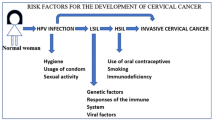Abstract
Cervical cancer is a leading cause of death by cancer among women worldwide. It is necessary to develop and refine cervical cancer models to more accurately reflect human tumor type. The relevance of cervical cancer to trace element was studied in this paper. By means of quantitative trace element analysis in models and patients with cervical cancer, the tissue and serum levels of trace elements in papillomaviruses-induced cancer models were more similar to that of patients than the levels in models induced by HeLa cell and methylcholanthrene. The results reflect papillomaviruses model most accurately mimic in vivo carcinogenesis of patients with cervical cancer. It will have a superior predictive value over HeLa cell and methylcholanthrene models in pre-clinical trials. The papillomaviruses-induced cervical cancer can provide more reliable models for testing the efficacy of drugs in treating human cancers.


Similar content being viewed by others
References
Parkin DM et al (2001) Cancer burden in the year 2000. Eur J Cancer 37:S4–S66
Kamb A (2005) What’s wrong with our cancer models? Nat Rev Drug Discov 4:161–165
Kung AL (2007) Practices and pitfalls of mouse cancer models in drug discovery. Adv Cancer Res 96:191–212
Olive KP, Tuveson DA (2006) The use of targeted mouse models for preclinical testing of novel cancer therapeutics. Clin Cancer Res 12:5277–5287
Van Dyke T, Jacks T (2002) Cancer modelling in the modern era: progress and challenges. Cell 108:44
Lv Y, Han L, Yuan C, Guo J (2009) Comparison of hypoglycemic activity of trace elements absorbed in fermented mushroom of Coprinus comatus. Biol Trace Elem Res 131:177–185
Xu Q, Guo J (2009) Activity and toxicity of Cr (III)-enriched Grifola frondosa in insulin-resistant mice. Biol Trace Elem Res 131:271–277
Cunzhi H, Jiexian J, Xianwen Z et al (2003) Serum and tissue levels of six trace elements and copper/zinc ratio in patients with cervical cancer and uterine myoma. Biol Trace Elem Res 94:113–122
Tsukamoto H, Shibata K, Kajiyama H et al (2008) Aminopeptidase N (APN)/CD13 inhibitor, ubenimex, enhances radiation sensitivity in human cervical cancer. BMC Cancer 8:74
Murphy ED (1953) Studies in carcinogen-induced carcinoma of the cervix in mice. Am J Pathol 29:608
Vassar R, Fuchs E (1991) Transgenic mice provide new insights into the role of TGF-alpha during epidermal development and differentiation. Genes Dev 5:714–727
Arbeit JM et al (1996) Chronic estrogen-induced cervical and vaginal squamous carcinogenesis in human papillomavirus type 16 transgenic mice. Proc Natl Acad Sci U S A 93:2930–2935
Hurlin PJ, Foley KP, Ayer DE et al (1995) Regulation of Myc and Mad during epidermal differentiation and HPV-associated tumorigenesis. Oncogene 11(12):2487–2501
Elson DA et al (2000) Sensitivity of the cervical transformation zone to estrogen-induced squamous carcinogenesis. Cancer Res 60:1267–1275
Moulder JE, Dutreix J, Rockwell S (1988) Applicability of animal tumor data to cancer therapy in humans. Int J Radiat Oncol Biol Phys 14:913–927
Marx J (2003) Medicine. Building better mouse models for studying cancer. Science 299:1972–1975
Johnson JI et al (2001) Relationships between drug activity in NCI preclinical in vitro and in vivo models and early clinical trials. Br J Cancer 84:1424–1431
Noguchi Y, Jungbluth A, Richards EC, Old LJ (1996) Effect of interleukin 12 on tumor induction by 3-methylcholanthrene. Proc Natl Acad Sci USA 93:11798–11801
Konno A, Hishinuma K, Hashimoto Y, Kimura S, Nishimura T (1991) Dietary restriction reduces the incidence of 3-methylcholanthrene-induced tumors in mice: close correlation with its potentiating effect on host T cell functions. Cancer Immunol Immunother 33:293–298
Rao AR, Hussain SP (1998) Modulation of methylcholanthrene-induced carcinogenesis in the uterine cervix of mouse by indomethacin. Cancer Lett 43:15–19
Basolo F, Fontanini G, Squartini F (1985) Morphology and progression of preneoplastic changes in methylcholanthrene-induced mouse mammary tumorigenesis. Tumori 71:1–11
Helt A et al (2002) Inactivation of both the retinoblastoma tumor suppressor and p21 by the human papillomavirus type 16 E7 oncoprotein is necessary to inhibit cell cycle arrest in human epithelial cells. J Virol 76:10559–10568
Author information
Authors and Affiliations
Corresponding author
Rights and permissions
About this article
Cite this article
Ji, J., Liu, J., Liu, H. et al. Comparison of Serum and Tissue Levels of Trace Elements in Different Models of Cervical Cancer. Biol Trace Elem Res 159, 346–350 (2014). https://doi.org/10.1007/s12011-014-9981-z
Received:
Accepted:
Published:
Issue Date:
DOI: https://doi.org/10.1007/s12011-014-9981-z




